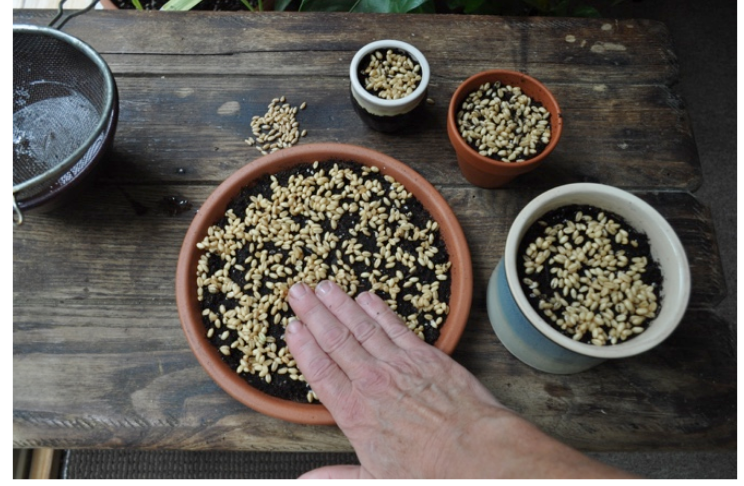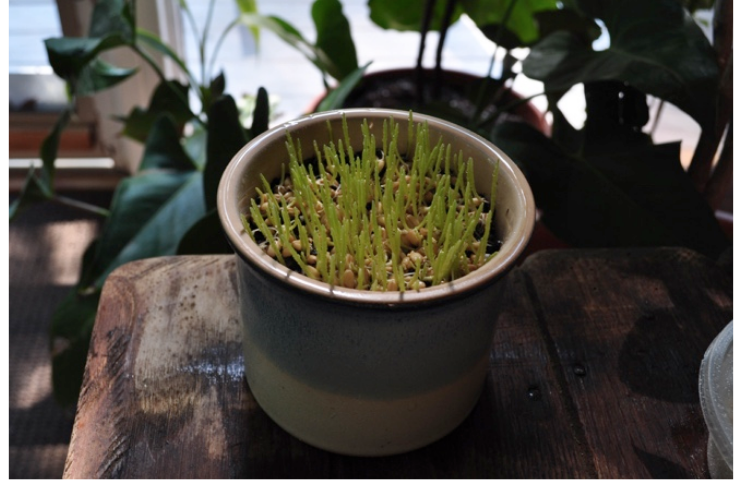
For craft-minded plant-lovers, wheatgrass offers endless opportunities for creative projects. Pretty pots of vibrant green wheatgrass make lovely centerpieces, and hand-painted pots are fun homemade gifts. How about a pot painted with a face, with tufts of wheatgrass as the hair?
What is Wheatgrass, Anyway?
Wheatgrass consists of the young leaves of grains. Usually, the grain is common wheat (Triticum aestivum); however, some people use the term “wheatgrass” for other grains, including rye, barley, and oats.
Wheatgrass Facts
Wheatgrass is gluten-free. Found in the seeds of several cereal grains, gluten is a type of protein contained in the seeds’ endosperm, which is a food storage structure that nourishes the plant embryo during germination.
That said, anyone with celiac disease or a severe allergy to gluten should avoid growing wheatgrass, due to the risk of exposure when handling the seeds.
Although the hype around wheatgrass might seem to be a recent phenomenon, the benefits of wheatgrass were recognized as early as 5,000 years ago in ancient Egypt. The plant was introduced to the modern world in the 1930s.
Wheatgrass is a source of vitamins, minerals, and other healthful substances, including potassium, vitamins A, B6, C, E, and K, iron, zinc, manganese, selenium, dietary fiber, and chlorophyll.
Cats and dogs often enjoy nibbling on wheatgrass. You can find kits for growing wheatgrass at pet supply stores.
How to Grow Wheatgrass

Wheatgrass growing guide
Prepare seeds and pots. Soak seeds in water overnight. Prepare containers by filling them to within ½” of the top with moist seed-starting mix or potting mix. Gently press the soil to fill any air pockets, and then smooth the surface.
Sow seeds. Strain and rinse the soaked seeds, and then scatter an even layer of seeds over the surface of the planting mix.
Press the seeds onto the soil surface. This ensures good seed-to-soil contact. There’s no need to bury the seeds.
Cover the pots with moist paper towels or newspapers. This will prevent the seeds from drying out. Place the pots in a location at room temperature, out of direct sunlight.
Check the pots daily. Use a plant mister to spritz the covering as needed to keep it moist. Peek underneath every few days; if the soil surface is dry, spritz it, too.
The seeds should germinate in 3-4 days.
When sprouts are about 1/2” high, remove the covering. Place the pots in bright light. Good locations include a windowsill that gets some direct sun, or under grow lights.
Check pots daily and water as needed to keep the soil moist. Shallow and porous pots may need a daily spritz.
Planting Tips
- Take care not to overwater or the seeds may rot. The soil should remain moist but never sopping wet. Use extra care when watering if you’re using pots without drainage holes.
- Protect surfaces with waterproof saucers, especially if you’re using porous clay pots or pots with drainage holes.
- If seeds haven’t sprouted in a week, something went wrong. Discard the seeds and soil and start over.
- Be on the lookout for signs of mold — fuzzy gray or white growth — and if found, discard the seeds and soil and start over. Sanitizing the pot with a 10% bleach solution between batches can help prevent contamination.
- Because they grow for such a short time, there’s no need to fertilize the plants.
Wheatgrass will look its best when it’s 3-4” tall. After that, the leaves may begin to turn yellow. Timing is key. Sow seeds 10-14 days before you want the plants at their peak. Consider sowing a few pots every two or three days, starting two weeks prior, if you need them ready on a specific day.
Harvesting
Wheatgrass is ready to harvest when it’s about 4” tall — usually 7-10 days after sprouting. Researchers discovered that the leaves contain the most nutrients when they’re harvested at the “jointing stage” — when they appear to split as the second leaf spear emerges. Use clean scissors to cut the grass about an inch above the soil line. The plant may re-sprout, giving you a second harvest in a week or so. Note: If you see signs of mold or rot, discard the batch.
Most people consume homegrown wheatgrass by pureeing it in a blender. However, wheatgrass tastes, well, like grass, and many people find it not-so-yummy on its own. Blending it with fruits, such as apples, pears, and grapes, makes it more palatable.
School-Grown - Wheatgrass Nourishes Animals in Need
A school in Queen’s Village, NY, gave their wheatgrass-growing project a benevolent twist. The students wanted to extend their love to creatures in need, so they donated some of their wheatgrass plants to a local animal rescue shelter for their cats to nibble on.
Download the Wheatgrass Growing Guide
KidsGardening.org is a national nonprofit focused on creating opportunities for kids to learn though gardening, engaging their natural curiosity and wonder by providing inspiration, community know-how and resources to parents and educators. Our website features a wide variety of lesson plans (https://www.kidsgardening.org/lesson-plans/), garden activities (https://www.kidsgardening.org/garden-activities/) and an extensive toolbox of gardening content(https://www.kidsgardening.org/gardening-toolbox/)





